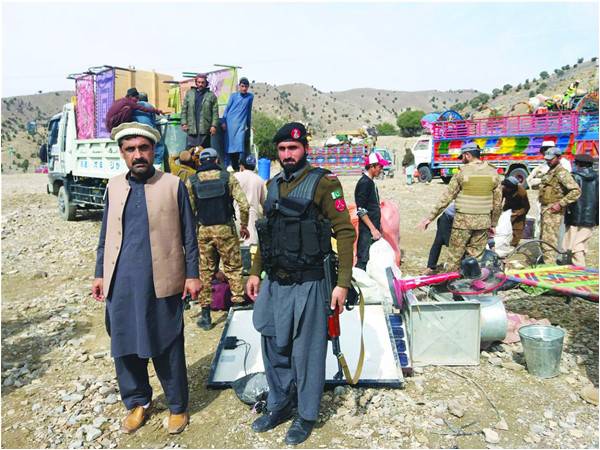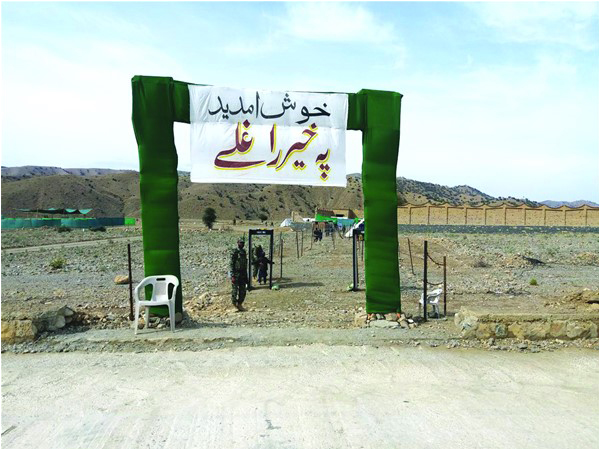
Caught between the politics of two countries, Pakistan and Afghanistan, the internally displaced from Pakistan’s tribal agency of North Waziristan Agency have finally begun their return home after a span of almost four years.
As of December 2017, more than 38,000 refugees in Khost province have been biometrically registered with active cases, says the UNHCR. Approximately 14,000 registered individuals in Khost are currently inactive or on hold as they have not collected recent food distributions.
In 2016, the UNHCR verified the registration of almost 36,000 refugees in Paktika province “where access remains a challenge on account of insecurity as anti-government elements control or contest a substantial amount of territory,” the agency notes. About 71% of these displaced people are children.
The second phase of repatriation which was supposed to begin in the first week of February 2018, hit a snag when the returning families were stopped two kilometers from the Ghulam Khan border pass on the Durand Line by the Afghan Border Police.
“They did not want them to return,” a Pakistani official said. “There is much to believe that these people might have come under the influence of hostile ‘agencies’. They would not want the human resource to move back to their home and live peacefully.”
The situation in North Waziristan, although not ideal, has relatively improved in terms of security. Basic facilities are scant and the reconstruction and rehabilitations is slow. Some displaced families have at times individually assessed the area to make a decision to return and many have expressed the desire to do so. “The pain of being kept away from one’s homeland is only known to those who want to return but can’t,” says Baram Wazir, who returned to North Waziristan along with his four children and wife.
The displaced are not allowed to speak much and have to spend a fair amount of time at the Bakakhel camp located in the Frontier Region of Bannu district. They have to go through a rigorous process of screening before they are allowed to go to go home. “We have made the process as easy as possible but the screening is necessary from a security perspective,” explained an official who was not authorised to speak to the media.
However, the politics of immigrants and displacement is a web spun from toxic statements exchanged between both Afghanistan and Pakistan. In June 2014, operation Zarb-e-Azb began and reports surfaced of displaced families who could easily move across the border into Afghanistan. The then governor of Khyber Pakhtunkhwa Sardar Mehtab had warned the Afghan government from taking in the displaced population from North Waziristan Agency. However, statements from the Afghan side, favouring the displaced people further angered the Pakistani establishment. Former president of Afghanistan, Hamid Karzai, even called a grand jirga of the displaced tribesmen and asked them to consider Afghanistan as their ‘permanent’ home ‘peacefully’.

The statements were not taken well in Pakistan as they came at a time when the country was thinking of expelling illegal Afghan refugees who had been residing in the country for more than three decades. The statements were also seen in the light of Mr Karzai’s statements about the Durand Line being a “controversial border”.
Four years on, there is, however, a desire among the displaced population to return home. Has the dust of vengeance finally settled? Time will tell. But the second phase of repatriation will bring home 12,000 families. The Ghulam Khan border which has remained closed for open trade, was supposed to be opened on March 7. This was suspended for an unknown period of time, officials confirmed.
“The border has not been opened on the order of higher authorities,” an official from area who wished to remain anonymous said. When asked what were the reasons behind the decision, the officials declined to comment.
The decision to open the Ghulam Khan border was taken at a grand jirga between the military and civil administration with the Uthmanzai Wazir tribe in Miranshah. It was decided that the border would be opened temporarily so that economic activity might resume. And initially only a few trucks would be allowed. However, the decision was retracted.
While the actual figures are not known, it is believed that there are around 98,000 people who took shelter in Afghanistan, mainly for the reason that Khost and Paktika were geographically closer and the scattered tribes on the Durand Line have relatives on both sides.
“There are problems with registration of people across our borders,” another official involved in the process on the Pakistani side said. “We have to send them the forms and they fill them and send them back. There is a dire need for cooperation from the Afghan side.”
While relations between both countries has been on a bumpy ride, it is very clear that those who suffer the most are not the governments, but their people.
The writer is a young senior journalist based in Peshawar and who covers Khyber-Pakhtunkhwa and Fata
As of December 2017, more than 38,000 refugees in Khost province have been biometrically registered with active cases, says the UNHCR. Approximately 14,000 registered individuals in Khost are currently inactive or on hold as they have not collected recent food distributions.
In 2016, the UNHCR verified the registration of almost 36,000 refugees in Paktika province “where access remains a challenge on account of insecurity as anti-government elements control or contest a substantial amount of territory,” the agency notes. About 71% of these displaced people are children.
The second phase of repatriation which was supposed to begin in the first week of February 2018, hit a snag when the returning families were stopped two kilometers from the Ghulam Khan border pass on the Durand Line by the Afghan Border Police.
“They did not want them to return,” a Pakistani official said. “There is much to believe that these people might have come under the influence of hostile ‘agencies’. They would not want the human resource to move back to their home and live peacefully.”
The second phase of repatriation was supposed to begin in the first week of February 2018. But returning families were stopped two kilometers from the Ghulam Khan border pass on the Durand Line by the Afghan Border Police
The situation in North Waziristan, although not ideal, has relatively improved in terms of security. Basic facilities are scant and the reconstruction and rehabilitations is slow. Some displaced families have at times individually assessed the area to make a decision to return and many have expressed the desire to do so. “The pain of being kept away from one’s homeland is only known to those who want to return but can’t,” says Baram Wazir, who returned to North Waziristan along with his four children and wife.
The displaced are not allowed to speak much and have to spend a fair amount of time at the Bakakhel camp located in the Frontier Region of Bannu district. They have to go through a rigorous process of screening before they are allowed to go to go home. “We have made the process as easy as possible but the screening is necessary from a security perspective,” explained an official who was not authorised to speak to the media.
However, the politics of immigrants and displacement is a web spun from toxic statements exchanged between both Afghanistan and Pakistan. In June 2014, operation Zarb-e-Azb began and reports surfaced of displaced families who could easily move across the border into Afghanistan. The then governor of Khyber Pakhtunkhwa Sardar Mehtab had warned the Afghan government from taking in the displaced population from North Waziristan Agency. However, statements from the Afghan side, favouring the displaced people further angered the Pakistani establishment. Former president of Afghanistan, Hamid Karzai, even called a grand jirga of the displaced tribesmen and asked them to consider Afghanistan as their ‘permanent’ home ‘peacefully’.

The statements were not taken well in Pakistan as they came at a time when the country was thinking of expelling illegal Afghan refugees who had been residing in the country for more than three decades. The statements were also seen in the light of Mr Karzai’s statements about the Durand Line being a “controversial border”.
Four years on, there is, however, a desire among the displaced population to return home. Has the dust of vengeance finally settled? Time will tell. But the second phase of repatriation will bring home 12,000 families. The Ghulam Khan border which has remained closed for open trade, was supposed to be opened on March 7. This was suspended for an unknown period of time, officials confirmed.
“The border has not been opened on the order of higher authorities,” an official from area who wished to remain anonymous said. When asked what were the reasons behind the decision, the officials declined to comment.
The decision to open the Ghulam Khan border was taken at a grand jirga between the military and civil administration with the Uthmanzai Wazir tribe in Miranshah. It was decided that the border would be opened temporarily so that economic activity might resume. And initially only a few trucks would be allowed. However, the decision was retracted.
While the actual figures are not known, it is believed that there are around 98,000 people who took shelter in Afghanistan, mainly for the reason that Khost and Paktika were geographically closer and the scattered tribes on the Durand Line have relatives on both sides.
“There are problems with registration of people across our borders,” another official involved in the process on the Pakistani side said. “We have to send them the forms and they fill them and send them back. There is a dire need for cooperation from the Afghan side.”
While relations between both countries has been on a bumpy ride, it is very clear that those who suffer the most are not the governments, but their people.
The writer is a young senior journalist based in Peshawar and who covers Khyber-Pakhtunkhwa and Fata

